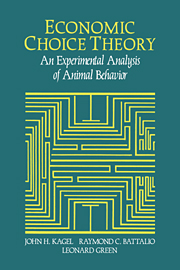Book contents
- Frontmatter
- Contents
- Preface
- Chapter 1 Introduction
- Chapter 2 Commodity-choice behavior I: Some initial tests of the theory
- Chapter 3 Commodity-choice behavior II: Tests of competing motivational processes and the representative consumer hypothesis
- Chapter 4 Labor-supply behavior I: Initial tests of the theory with some public policy implications
- Chapter 5 Labor-supply behavior II: Tests of competing motivational processes and earnings distributions for animal workers
- Chapter 6 Choices over uncertain outcomes
- Chapter 7 Intertemporal choice
- Chapter 8 Summing up
- Bibliography
- Index
Chapter 6 - Choices over uncertain outcomes
Published online by Cambridge University Press: 22 March 2010
- Frontmatter
- Contents
- Preface
- Chapter 1 Introduction
- Chapter 2 Commodity-choice behavior I: Some initial tests of the theory
- Chapter 3 Commodity-choice behavior II: Tests of competing motivational processes and the representative consumer hypothesis
- Chapter 4 Labor-supply behavior I: Initial tests of the theory with some public policy implications
- Chapter 5 Labor-supply behavior II: Tests of competing motivational processes and earnings distributions for animal workers
- Chapter 6 Choices over uncertain outcomes
- Chapter 7 Intertemporal choice
- Chapter 8 Summing up
- Bibliography
- Index
Summary
Chapters 2 through 5 considered animals' choices between certain payoffs, which constitute the framework in which consumer-demand and labor-supply theories were originally developed. In those few cases where the experimental procedures subjected animals to uncertain outcomes – for example, where their labor supply was studied under variable-ratio schedules of reinforcement (Section 4.3a) – we ignored the effects of uncertainty on choice and confined the analysis to the average rate of reinforcement. This chapter explicitly considers the effects of uncertainty on animals' choices.
Choice under uncertainty has been a subject of enduring interest to economists, psychologists, and behavioral biologists. Expected utility theory is common to much of the social sciences and has an extensive and long history of experimental studies in economics and psychology using primarily hypothetical choice protocols with humans. The study of nonhuman animals' choices over uncertain outcomes has a more uneven history. In the 1960s, psychologists focused on the study of alternatives with identical payoffs but with different probabilities of reward – psychologists called these “probability learning experiments.” Economists know them as “tests of first-degree stochastic dominance.” Section 6.1 develops the concept of first-degree stochastic dominance and reviews these early probability learning experiments, along with the discretetrial choice procedures that underlie our experimental work.
In the early 1980s, biologists (most notably Caraco, 1981, 1982; Caraco, Martindale, and Whittam, 1980) extended the study of choice under uncertainty beyond questions of first-degree stochastic dominance to test for risk aversion over uncertain food payoffs. In these experiments, animals made choices between a certain food reward and an uncertain one with equal expected value.
- Type
- Chapter
- Information
- Economic Choice TheoryAn Experimental Analysis of Animal Behavior, pp. 134 - 172Publisher: Cambridge University PressPrint publication year: 1995



